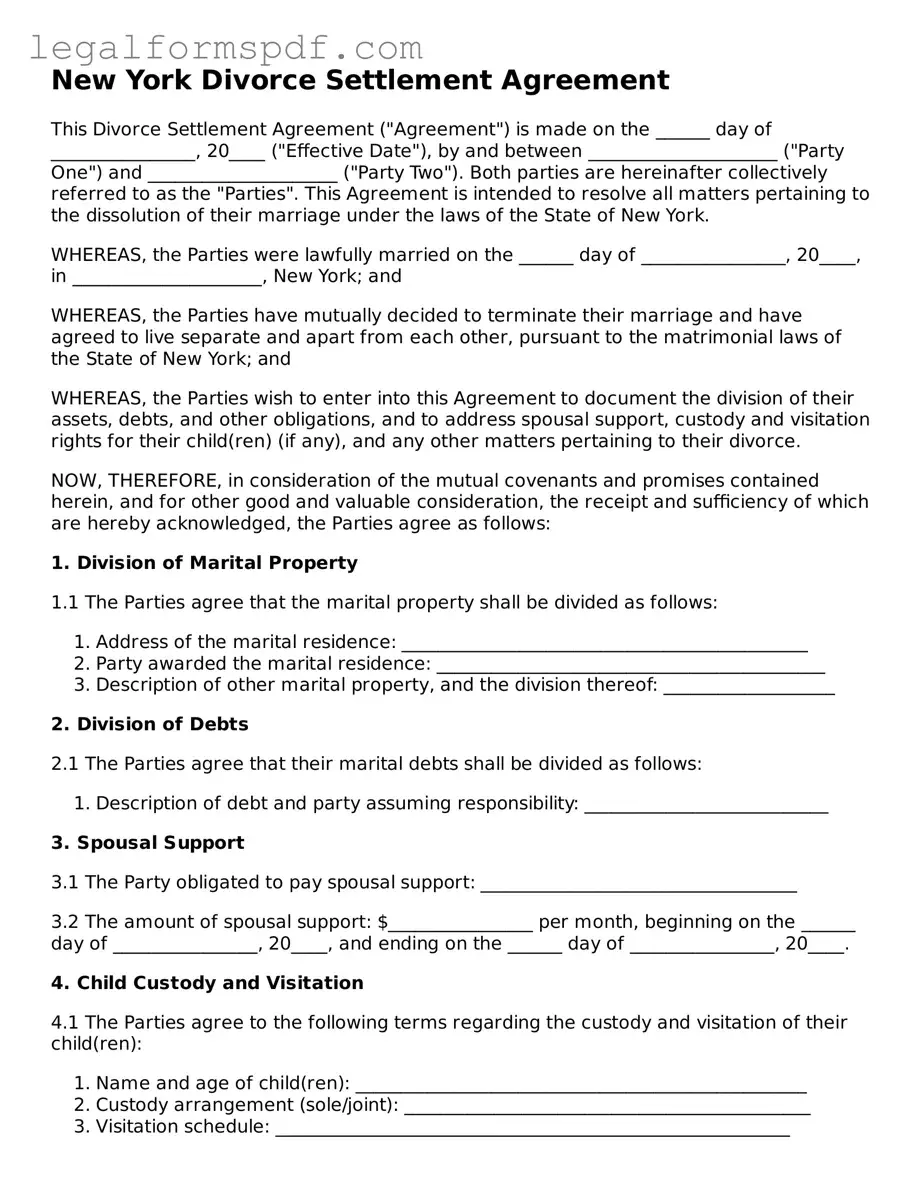New York Divorce Settlement Agreement
This Divorce Settlement Agreement ("Agreement") is made on the ______ day of ________________, 20____ ("Effective Date"), by and between _____________________ ("Party One") and _____________________ ("Party Two"). Both parties are hereinafter collectively referred to as the "Parties". This Agreement is intended to resolve all matters pertaining to the dissolution of their marriage under the laws of the State of New York.
WHEREAS, the Parties were lawfully married on the ______ day of ________________, 20____, in _____________________, New York; and
WHEREAS, the Parties have mutually decided to terminate their marriage and have agreed to live separate and apart from each other, pursuant to the matrimonial laws of the State of New York; and
WHEREAS, the Parties wish to enter into this Agreement to document the division of their assets, debts, and other obligations, and to address spousal support, custody and visitation rights for their child(ren) (if any), and any other matters pertaining to their divorce.
NOW, THEREFORE, in consideration of the mutual covenants and promises contained herein, and for other good and valuable consideration, the receipt and sufficiency of which are hereby acknowledged, the Parties agree as follows:
1. Division of Marital Property
1.1 The Parties agree that the marital property shall be divided as follows:
- Address of the marital residence: _____________________________________________
- Party awarded the marital residence: ___________________________________________
- Description of other marital property, and the division thereof: ___________________
2. Division of Debts
2.1 The Parties agree that their marital debts shall be divided as follows:
- Description of debt and party assuming responsibility: ___________________________
3. Spousal Support
3.1 The Party obligated to pay spousal support: ___________________________________
3.2 The amount of spousal support: $________________ per month, beginning on the ______ day of ________________, 20____, and ending on the ______ day of ________________, 20____.
4. Child Custody and Visitation
4.1 The Parties agree to the following terms regarding the custody and visitation of their child(ren):
- Name and age of child(ren): __________________________________________________
- Custody arrangement (sole/joint): _____________________________________________
- Visitation schedule: _________________________________________________________
5. Child Support
5.1 The Party obligated to pay child support: _____________________________________
5.2 The amount of child support: $________________ per month, per child, beginning on the ______ day of ________________, 20____, and ending on the ______ day of ________________, 20____.
6. Miscellaneous
6.1 The Parties agree that any disputes arising out of or related to this Agreement shall be resolved through mediation, and if necessary, arbitration, in accordance with the laws of the State of New York.
6.2 This Agreement constitutes the entire understanding between the Parties relating to the subject matter hereof and supersedes all prior or contemporaneous agreements, representations, or understandings, whether oral or written.
IN WITNESS WHEREOF, the Parties have executed this Agreement on the date first above written.
Party One's Signature: ___________________________________ Date: ________________
Party Two's Signature: ___________________________________ Date: ________________
